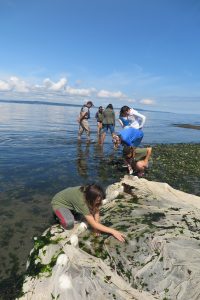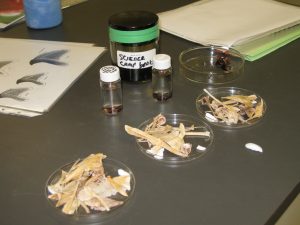NOAA Science Camp has brought a breadth of marine programming to middle and high school students since 2003
From the Winter 2023/2024 Sea Star
By Samantha Larson, WSG Science Writer
Minutes away from Seattle’s Space Needle and skyscrapers, a pocket beach along the waterfront hosts an abundance of marine life. On a warm day in July this past summer, about two dozen middle schoolers poked through these tidepools, uncovering animals many of the students had never even heard of before — spiny pink scallops, lampshells, creeping pedal sea cucumbers, and hairy shore crabs among them. “It’s amazing, we’re right on the edge of downtown, and here are all these amazing creatures we share our beaches with,” said Jen Strongin, a naturalist with the Seattle Aquarium who served as a marine tour guide for the kids that day.

High school students conduct research as part of the Junior Leadership Program.
For the past 20 years, NOAA Science Camp has captured the imaginations of middle and high school students every summer and introduced them to cutting-edge science through activities led by real-life experts. The camp has experienced many twists and turns since it was founded in 2003, but one thing has remained consistent: a recognition of the importance of providing students with engaging, hands-on science experiences early in their education.
The idea for the camp came from Lieutenant Commander (LCDR) Tom Callahan, a NOAA Corps Officer working at the NOAA National Ocean Service’s Office of Response and Restoration in the early 2000s. The NOAA Western Regional Center, located on Lake Washington in Seattle, is home to the largest NOAA staff outside the headquarters near Washington, D.C., with NOAA programs from all of NOAA’s main line offices (NOAA Fisheries; National Weather Service; National Ocean Service; Office of Oceanic and Atmospheric Research; Office of Marine and Aviation Operations; and National Environmental, Satellite, Data and Information Service). These offices each do distinct work, from fisheries and marine mammal research to oil spill response to weather forecasting. With such a breadth of knowledge and experience available, LCDR Callahan envisioned a NOAA “show and tell” program tailored for a middle school audience, as there were few summer programs aimed at that group. This first iteration of NOAA Science Camp was held in 2003.
The initial camp was such a success that several NOAA scientists worked together to expand and hold it again the next year. At the same time, the NOAA staff began to come to terms with the enormous workload involved in holding such an event. If they wanted to continue, “We realized that we would need to partner with an organization to do the logistical side,” says Lisa Hiruki-Raring, education and outreach coordinator at the NOAA Alaska Fisheries Science Center. “We thought Washington Sea Grant would be the perfect partner.”
Washington Sea Grant (WSG) came onboard in 2005, and Maile Sullivan, WSG education specialist, joined the team in 2006. Together, the Science Camp team worked to develop a more robust, weeklong summer program. “We honed in on middle school as the target audience, since research suggests that’s the point at which youth interest in science, technology, engineering and math starts to plummet,” Sullivan says.
They developed a program curriculum that integrates a broad range of NOAA science, presenting complex concepts in innovative and interesting ways. Solving an “environmental mystery” became a core thread throughout the week: at the beginning of the week, camp staff would present a mysterious event — say, a big fish die-off — and then the students would spend the next few days visiting various NOAA offices in which they learned about marine topics while piecing together the clues to solve the puzzle. For example, in the fisheries lab students would learn to identify fish species while checking for signs of wounds, trauma or disease; at the oceanography station students would practice measuring the chemical properties of ocean water; and in the marine mammal lab, students would analyze seal scat, looking for remnants that could help identify what the animal had for dinner.
A few years down the road, staff began getting feedback from students and parents that they wanted opportunities to continue in camp beyond middle school. In 2011, the Junior Leadership Program (JLP) was launched for high school students interested in diving deeper into NOAA research. Over two weeks, the junior leaders participate in field trips in which they gain scientific research experience by building and implementing data-collecting buoys, testing water quality, conducting boat and beach surveys on Puget Sound, and communicating the results of their research. They also get professional development opportunities such as a two-hour networking session in which they can learn about the careers of various NOAA scientists and gain job interview skills.

Fish bones can be one clue helping students solve an “environmental mystery.”
Science Camp staff continued to look for ways to expand their offerings — such as holding mini-sessions focused on robotics and engineering in 2016 and 2017, during which middle schoolers learned about and constructed their own underwater remotely operated vehicles. Before long, Science Camp staff also started seeing the path they helped chart for former campers: there was a growing trend of middle school campers becoming junior leaders, who then became camp staff assistants, who then became college students pursuing ocean-related majors.
In other words, Science Camp turned into a fairly “well-oiled machine,” says Sullivan, hosting about 100 middle school and 20 high school students every summer. That is until the pandemic hit. During the summers of 2020 through 2023, what had become the typical NOAA Science Camp wasn’t possible due to health and safety precautions as well as closures at the NOAA Western Regional Center.
But far from stopping altogether, NOAA Science Camp pivoted to a new direction. In the summers of 2020, 2021 and 2022, Science Camp offered virtual programming including a webinar series, guides for at-home Science Camp activities, and an online networking event for junior leaders. In the summer of 2023, the Science Camp team dipped back into in-person programming by hosting one week of camp specifically for students from two middle schools in underserved communities.
“The pandemic allowed us to press pause and look at what was still working for us, and what could be changed to adapt to different priorities,” says Sullivan. Practicing inclusivity and creating opportunities for underserved students had long been a focus for Science Camp: over the years, camp staff worked with community partners to provide scholarships to students who might not otherwise be able to access summer camp, including sponsoring several Alaska Native students to travel and attend camp, as well as providing accommodations and programming for students with disabilities. The 2023 Science Camp, tailored for underserved students in the Seattle area, provided a chance for staff to brainstorm on how they might expand program offerings to broader communities beyond a week at camp, even as they plan to return to more typical programming in the summer of 2024.
“I think the next 20 years of Science Camp will look quite different,” says Sullivan. “It’s not lost on me that there will still be the kids who were born wanting to be marine scientists — and we want to keep those kids engaged. But we also want to really prioritize opening doors for kids who have never been told that these types of opportunities exist for them.”
Learn more about NOAA Science Camp.
###
Washington Sea Grant, based at the University of Washington, helps people and marine life thrive through research, technical expertise and education supporting the responsible use and conservation of coastal ecosystems. The National Sea Grant College Program is part of the National Oceanic and Atmospheric Administration, U.S. Department of Commerce.
Join the conversation: instagram.com/waseagrant and Facebook.com/WaSeaGrant.
MAR
2024